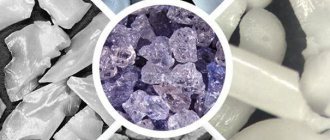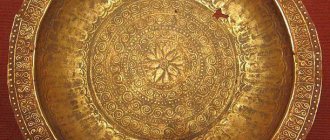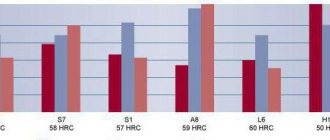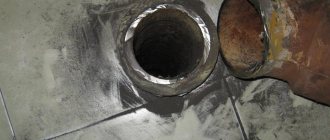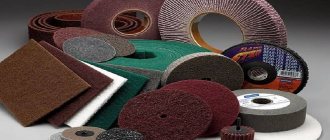Some industries in the metallurgical, energy, mining and processing industries, and scientific research require technological complexes and installations; laboratory furnaces, devices lined on the inside with refractory materials, piece goods, capable of withstanding constant or cyclic exposure to high temperatures of raw materials, reacting substances, and products.
Often, when constructing particularly important construction projects that have an increased fire hazard, it is necessary to use load-bearing structures made of fire-resistant (fire-resistant) concrete.
Fireproof products in assortment
Purpose and properties
GOST 28874-2004, which classifies all types (types) of refractories, defines fire resistance as the property of materials to withstand exposure to high temperatures without going into a molten state.
GOST R 52918-2008 defines refractories . They are called non-metallic materials that have a fire resistance of at least 1580 ℃ and are used in units and devices for protection from the effects of thermal energy and gas, liquid, and solid aggressive reagents.
Refractory products include refractories that have specified geometric shapes and dimensions.
In general, refractories are materials, finished molded products, made mainly from mineral raw materials, which are able to retain their fire-resistant properties under conditions of long-term operation at very high ambient temperatures, including aggressive ones; serving as protective coatings for various production, laboratory and experimental equipment or load-bearing building structures.
Purpose of refractories:
- Protection of housings, parts of installations, units, any other equipment with working areas, the surfaces of which, inside or outside, are exposed to molten raw materials, a reacting environment during the technological process, finished products with temperatures above 1580 ℃.
- Ensuring a long period of preservation of load-bearing properties, geometric immutability of the shapes of building structures in conditions of fire development at particularly important facilities.
Properties of fireproof materials and finished products, in addition to the main one - high fire resistance, demanded by customers:
On this topic ▼
Non-combustible materials and substances
Types, classification, application
- Low thermal conductivity coefficient.
- Thermal resistance to linear/volumetric expansion.
- Resistance to various types of aggressive environments, including radiation exposure.
- Long period of operation.
- Low cost.
In addition, in production there is a demand for such a parameter as the ability to quickly replace the protective layer of refractory materials, a set of piece products during planned shutdowns, emergency repairs of industrial equipment with high-temperature working areas.
Gallium
The second most fusible metal is gallium. It becomes liquid at temperatures above 29.5 degrees Celsius, and can be softened simply by holding it in your hands for a while. Under normal conditions, gallium is very brittle, easily amenable to mechanical action, and has a light silver, somewhat bluish tint.
The metal is very dispersed in the earth's crust and is not found in the form of nuggets. In nature, it is found in various minerals, such as garnet, muscovite, tourmaline, chlorite, and feldspar. In addition, it is found in sea water. Gallium is used in high-frequency electronics, for the manufacture of mirrors and various alloys.
Classification
Refractories are divided into two main classes - unshaped materials and molded (piece) products.
Molded refractories
Unshaped refractory materials include:
- Refractory cements.
- Concrete mixtures, shotcrete masses with high fire resistance.
- Different types of powders for filling metallurgical furnaces.
- Mortals.
- Plastic refractory pastes, suspensions.
Molded refractory products , mass-produced using hot, semi-dry pressing technologies of plastic molding; casting, including vibration, from melts, fluid masses of prepared raw materials; By cutting large blocks and rocks, they make:
- Straight, wedge of various sizes, formats.
- Shaped of varying complexity, mass of serial product.
- Special - industrial or laboratory use. The latter include crucibles, cuvettes, and equipment for conducting research at high temperatures.
Refractory materials and products are classified according to the following basic parameters:
- According to physical condition.
- Chemical composition.
- Fire resistance.
- Density, porosity.
- Shape, size, weight.
- Forming methods.
- Areas of use.
Based on fire resistance they are divided into four groups (classes):
- Fireproof, withstanding operating temperatures in the range of 1580-1770 ℃.
- With high fire resistance - 1770-2000 ℃.
- With the highest fire resistance - 2000-3000 ℃.
- Super fire-resistant - more than 3000 ℃.
According to porosity, there are eight classes - from especially dense refractories, the open porosity of which is less than 3%, high-density - 3-10%, dense - 10-16%; to ultra-porous, where it exceeds 75%.
Depending on the shape, geometric dimensions, weight, refractory products are classified:
- Rectangular, including refractory bricks of standard building sizes.
- Shaped in various configurations, including curved shapes.
- Sheets, rolls.
- Linear products - more than 450 mm.
- Piece - up to 2 kg.
- Blocks - from 2 kg to 1 t.
- Large blocks - more than 1 t.
According to the physical state of the finished product upon delivery to customers:
- Unshaped materials - dry, semi-dry mixtures; liquid, plastic ready-made solutions.
- Piece products.
- Building fireproof structures.
Unshaped refractory materials are also qualified according to the main methods of application to the protected surfaces of production equipment and building structures:
- Spraying.
- Coating.
- Casting.
- Shotcrete.
- Vibration compaction.
- Tamping.
- Pressing.
- Sand-jet packing.
There are other classifications of refractories based on methods of preparing raw materials, producing unshaped materials, manufacturing piece goods, and building structures.
Main types and types
This division is based on differences in the chemical composition of refractory unshaped materials and finished products. It is generally accepted to put the predominant component first in the name of the refractory:
- Siliceous – these are heat-resistant materials that consist of more than 90% SiO2. These include silica refractories, widely used for lining metallurgical and other types of furnaces; quartz glass, from which the entire range of heat-resistant glassware and laboratory equipment is made. Fire resistance of silica materials is up to 1730 ℃, quartz glass – up to 1200 ℃.
- Aluminosilicate . Their main components are Al2O3, SiO2. Depending on the percentage of Al2O3, they are semi-acidic - 14-28%; fireclay – 28-45%; high-alumina – 45-95%. The fire resistance of high-alumina materials is over 1750 ℃.
- Magnesium based on MgO, fired during production in the temperature range of 1500-1900℃. Their fire resistance leads to widespread use in the metallurgical industry, which is also facilitated by high strength and resistance to contact with moving molten metals and slag masses.
- Periclase are magnesium refractory materials with a MgO content of over 85%.
- Periclase-carbon materials are made from periclase refractory powder with the addition of 6-25% graphite with an organic binder, for example, phenol with ethylene glycol.
- Chromium , produced from the mineral chromite with a melting point of 2180℃. The great advantage of these heat-resistant materials is their inert resistance to both acidic and basic metallurgical slags.
- Zirconium . Their main components are the mineral baddeleyite, containing up to 62% ZrO2 and ZrSiO4. Fire resistance – 2700 ℃, excellent resistance to contact with molten metals, high strength.
- Carbonaceous . Their main component is free carbon, compounds with a high content of carbon. The firing of raw materials occurs at temperatures from 1100 to 2000 ℃, after which the range of their use is the lining of electrothermal, metallurgical furnaces (blast furnaces, open hearths), industrial installations for smelting non-ferrous metals, and nuclear power plant reactors. The fire resistance of carbon varieties reaches 3500℃, and graphite, its crystalline variety, reaches 3800℃.
- Oxide-carbon are refractories created on the basis of oxides of magnesium, barium, calcium, beryllium with hydrocarbons, which have high fire resistance.
- Oxygen-free ones are made from refractory chemical compounds - nitrides, silicides, sulfides, borides, carbides. Their use in oxidizing environments is limited.
- Dolomite , consisting of a mixture of magnesium and calcium oxides after firing dolomite rocks, fire-resistant up to 2300℃.
This is not a complete list of types (types) of refractories, which are also produced from other raw materials, with various additives.
Application area
Refractory unshaped materials, piece products, due to the range of products in demand by scientists, specialists of design, construction organizations, and manufacturing enterprises, are used in various branches of production and science:
- in the glass and cement industries;
- in metallurgy of ferrous and non-ferrous metals;
- in energy;
- in aviation and rocket science, both in the creation of engines and as protective super-heat-resistant coatings;
- in the nuclear industry;
- in production and educational laboratories - muffle furnaces, refractory cookware.
Pouring metal into fireproof baths
Thus, unmolded refractories are used to create and repair protective coatings - linings:
- Industrial heating furnaces, firing of raw materials - high-alumina mixtures, fireclay.
- Furnaces for the production of coke - coating.
- Ladles for pouring steel, cast iron – magnesia, silica, high-alumina masses.
- Electric induction furnaces – periclase, corundum gunite masses.
- Open hearths, arc furnaces – refractory metallurgical powders.
Molded refractories, in the form of piece products of various shapes, thicknesses, and sizes, are used as follows:
- For laying out hearth foundations, erecting high-temperature-resistant walls, vaults, and other elements of metallurgical furnaces, converters for the smelting of ferrous and non-ferrous alloys, and thermal power plant boilers.
- To create reliable linings for nuclear power plant reactors.
- To protect the working surfaces of aircraft and rocket engines heated to ultra-high temperatures.
When using piece products during the production of protective coatings, the construction of lining masonry for equipment of various purposes, the seams between them are carefully, throughout the entire volume, filled with unmolded refractory materials, ensuring the integrity, and after the initial firing during operation, the solidity of the protective layer.
In addition, unmolded refractories are applied in a continuous layer to masonry made from piece goods, increasing the thickness, and therefore the thermal insulation and fire resistance of such a “pie”; as well as on the load-bearing structure of buildings and structures made of metal, providing reliable, long-term fire protection of metal structures; as well as factory-made, monolithic reinforced concrete structures at particularly important fire protection sites.
Mercury
Useful in many areas, but poisonous metal was known even before our era. Mercury was used by ancient and medieval physicians to treat venereal and many other diseases; alchemists tried to make gold from it. Today it is used in electrical engineering, instrument making and organic chemistry.
Ruth is the most fusible metal on the planet. Under normal room conditions, it is always liquid, since its melting point is -39 degrees. Its vapors are very dangerous, so mercury is contained only in containers and special glass flasks. It acts like a poison on the body, poisoning it and disabling the nervous, immune, respiratory and digestive systems.


